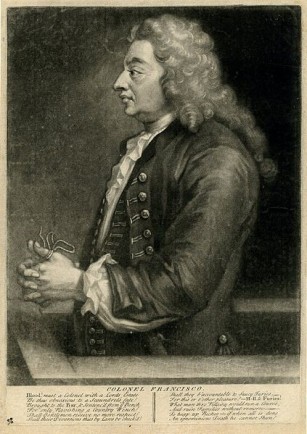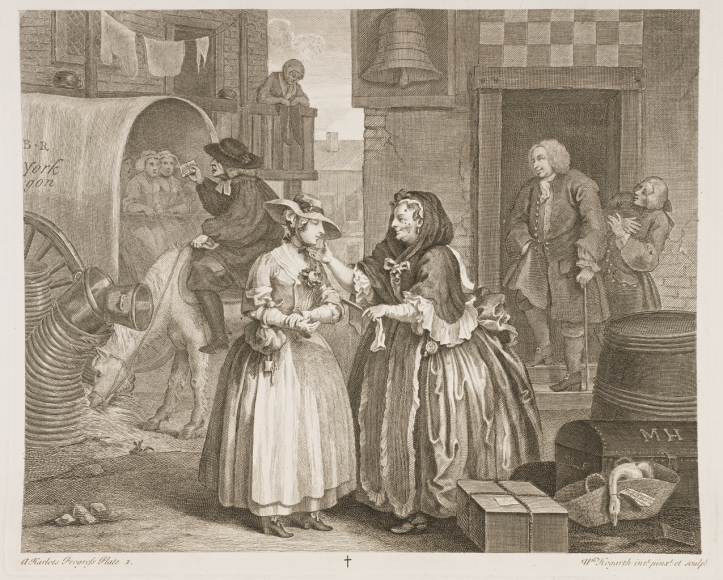
For some people the word ‘rake’ is applied almost as a compliment–a recognition of hard-living and hard-drinking, with an almost heroic life spent on gambling and fornicating. But there was nothing heroic about Francis Charteris; he was not just a rake, he was a rapist, and a serial one at that. There are few men from the Eighteenth Century who come across as so totally devoid of decency and morality. Here was a thoroughly nasty piece of work–Swift described him as “a most infamous, vile scoundrel.”
Redeeming features? None that anyone could see. He was born in 1675 into a wealthy aristocratic Scottish family. He joined the army and was chucked out on four occasions, most notably by the Duke of Marlborough who had him court-martialed for cheating at cards. Eventually he was dismissed by Parliament for accepting bribes. By then he had achieved the rank of colonel–a rank which he had purchased largely through his expertise at cards. On one occasion he fleeced the Duchess of Queensbury out of £3000 by the simple expedient of playing cards with her after positioning her in front of a mirror, enabling him to see each hand of cards reflected in the glass.
He amassed money through bribery, fraud and blackmail as well as by dabbling on the nascent stock market (he was one of the few who did not get burned when the South Sea Bubble burst in 1720). He would lend money at an exorbitant rate of interest – sometimes 100%. It was small wonder that he reputedly had an income of £7000 a year, as well as a hundred thousand pounds invested in stocks and shares. He was a bully, a cheat and a con-artist, and a man who apparently thought he could have any woman he wanted, under some twisted idea of ‘droit de signeur.’ On one occasion in Scotland he raped a married woman at gunpoint, before running away to England to avoid capture. That meant that he was unable to return to the country of his birth, where he owned substantial estates, but in 1721 was able to petition the king (George I) for a pardon.
Armed with the pardon, he clearly felt that he was free to commit rape with impunity–he reveled in the name “Rape-Master General” and bragged of having had his way with some three hundred women. Nathaniel Mist, in his ‘Weekly Journal’, wrote “We hear a certain Scotch Colonel is charged with a Rape, a misfortune he has been very liable to, but for which he has obtained a Nolle Prosequi. It is reported now that he brags that he will obtain a Patent for ravishing whomever he pleases.”
Honour had no place in his repertoire. On one occasion when staying at an inn in Lancaster he reportedly persuaded a young servant girl to have sex with him on payment of a gold guinea. The next day, before departing, he told the inn-keeper that he had given the girl a gold coin and asked her to have it changed into silver, and that she had failed to deliver his change. The girl was searched, the gold coin discovered, and of course the word of Colonel Charteris was accepted, and the girl’s protestations were in vain: he got his guinea back, and she got the sack.
One of the drawbacks of his notoriety was that it was well-nigh impossible to find female servants to work in his household, so when he needed a new servant-girl for his home at Hanover Square in London, he gave his name as Colonel Harvey. It was apparently part of a ritual, played out for the amusement of the somewhat fat fifty-four year old colonel and his friends. Girls would be hired, raped, and then pushed out onto the streets.
As the Newgate Calendar put it: “his house was no better than a brothel, and no woman of modesty would live within his walls. He kept in pay some women of abandoned character, who, going to inns where the country waggons put up, used to prevail on harmless young girls to go to the colonel’s house as servants; the consequence of which was, that their ruin soon followed, and they were turned out of doors, exposed to all the miseries consequent on poverty and a loss of reputation.”
In October 1729 a young woman called Anne Bond was taken on as a maid-servant and was immediately besieged by the loathsome lothario. She resolutely declined the Colonel’s demands for sexual favours. On the third day she overheard someone refer to her master as Colonel Charteris. Realizing who ‘Colonel Harvey’ was, she sought to leave his employment immediately. He responded by having her locked in her room. The next day, 10th November 1729, he sent for her demanding that she make up the fire. He then brutally raped her, after gagging her screams with his night cap. When she stated her intention to report the crime, had her stripped and horse-whipped, alleging that she was a thief. She was thrown out with no possessions.
Brave girl –she made a complaint against Charteris and initially he was charged with the misdemeanour of assault with intent to rape. The Middlesex Jury upgraded the charge to rape, a crime which carried the death penalty. The case was referred to the Old Bailey and the trial started on 27 February 1730. By then the trial was the subject of huge Press attention. His defense team tried to besmirch Anne Bond’s character, claiming that she was a prostitute and a thief. He claimed that the act was consensual, producing his household servants to give evidence that the girl was lying, and that they had heard no noises or screams at the time of the alleged offence. Charteris even produced a letter which his footman swore on oath came from the girl, but it was clearly a forgery. Three witnesses were produced to give evidence that Anne was a virtuous and religious young woman. The jury retired for just 45 minutes to consider its verdict, and on 2 March Charteris was found guilty and sentenced to death.
That should have been the end of the matter–he was carted off to Newgate prison and his goods were seized as being forfeit to the Crown. He was, it transpired, one of ten men sentenced to death by the court that day.
However, a campaign to pardon the appalling colonel got under way–it appears that he had ‘friends in high places’ not least with Robert Walpole, First Lord of the Treasury. More to the point, he seems to have been able to buy off Anne Bond with the promise of an annual sum of £800, enough for her to get married. She planned to open a public house, apparently to be named ‘The Colonel Charteris Head.’ The sum of fifteen thousand pounds was apparently spent on ‘oiling the wheels of justice’ (in other words, laid out in bribes). It worked. Six weeks after sentence was handed down, George II granted a Royal Pardon, and the man was set free. He then had the nerve to sue for the return of his goods, even though his conviction as a felon meant that the seizure was entirely lawful. He ended up having to sell shares to obtain the return of his chattels. Meanwhile the Press also alleged that he made a substantial ‘thank you’ gift to Sir Robert Walpole….

The public were outraged–the poor because it was a clear example that the rich could get away with anything, and the rich because he was a disgrace and a dishonest cheat. He was pilloried in the Press with books such as “Some authentick memoirs relating to the life, amours … of Colonel Ch—-s. Rape-Master General of Great Britain.” A ballad entitled “On General Francesco, Rape-Master General of Great Britain” was published and he became the subject of satirical attacks by popular writers such as Alexander Pope, John Arbuthnot and Jonathan Swift.
Charteris returned to Edinburgh in ill-health, possibly as a result of illness contracted in prison. He died on 24 February 1732. The outraged citizens of Edinburgh saw no reason why he should receive the full sacrament–they chased away the clergyman conducting the funeral, and pelted the grave at Greyfriars with manure, offal, and dead cats.
His conduct and unpopularity coincided with a campaign aimed at discrediting Walpole, who was seen as corrupt. The idea that “the rich can get away with it” was echoed in John Gay’s The Beggars Opera, which cast the hero as a highwayman and posed the question: why do the poor get punished for their crimes, when the rich do not?
 Mike Rendell retired as a lawyer 15 years ago and now writes and lectures on Georgian history. He has written The Journal of a Georgian Gentleman based on the treasure trove of family papers (diaries, day books, etc) kept by his 4x great grandfather. His next book, In Bed With The Georgians: Sex, Scandal, and Satire in the 18th Century, will be out in October from Pen & Sword Books. You can visit him at http://mikerendell.com.
Mike Rendell retired as a lawyer 15 years ago and now writes and lectures on Georgian history. He has written The Journal of a Georgian Gentleman based on the treasure trove of family papers (diaries, day books, etc) kept by his 4x great grandfather. His next book, In Bed With The Georgians: Sex, Scandal, and Satire in the 18th Century, will be out in October from Pen & Sword Books. You can visit him at http://mikerendell.com.

My gosh! As I kept reading this, I built such a great hatred towards this man. Absolutely despise him. I think it’s because of what’s been going on with rape crimes these days. But it’s absolutely true that the wealthy do get away with lots of things because of money and influences, even nowadays it’s still happening.
LikeLike
When I prepared the post I simply couldn’t believe that the man could get away with it. After all, everyone KNEW he was a rapist. An extraordinary indictment of the corrupt legal system, and on the morals of the aristocracy. I felt I had to wash my hands after writing about him!
LikeLike
Is that Dora Jordan on your cover?
LikeLike
The young minx on the cover is from a print by Charles White after a painting by Rev Matthew William Peters – a vicar who liked painting near-nudes! The British Museum describe her as “Unknown woman seated half-length to front, her head tilted to right, her left hand holding her right breast above her bodice, beneath transparent shawl; wearing large, plumed hat and pearl bracelet”. It was dated too early to be Ms Jordan, as far as I can tell. Since choosing her for the cover I was amazed and delighted to be given the original print and she now has pride of place in my study!
LikeLike